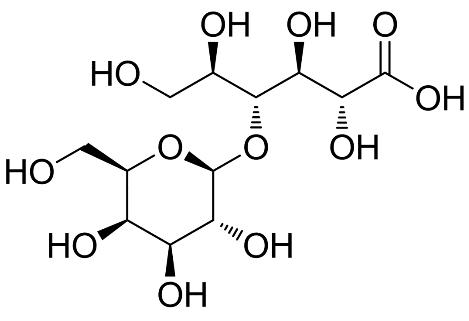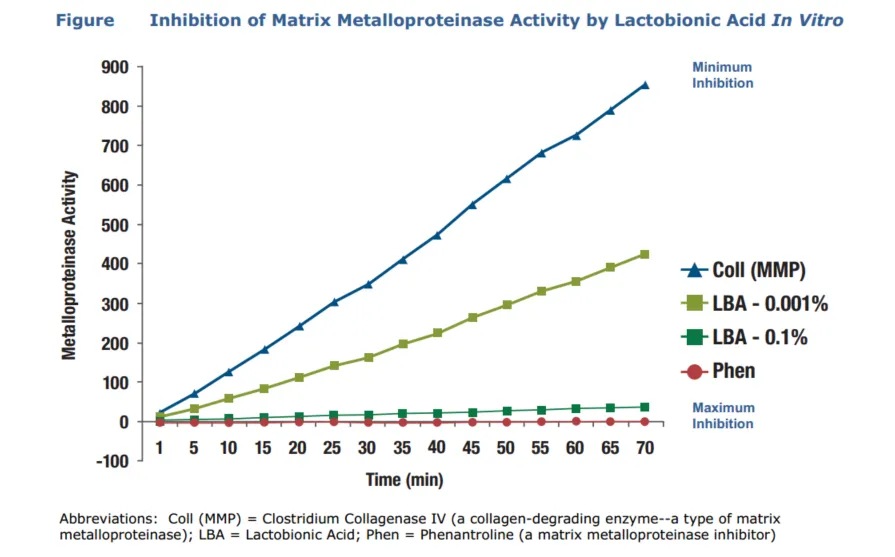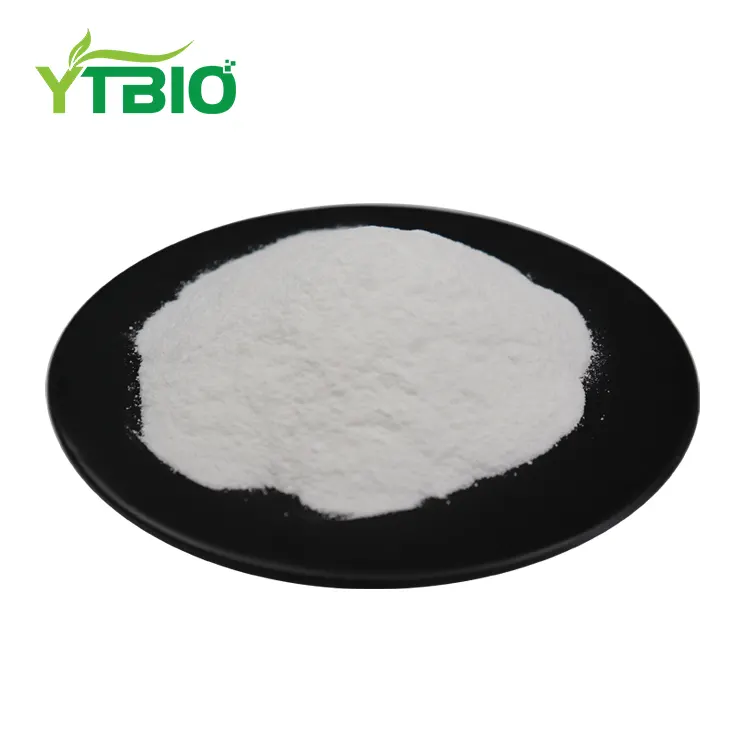Bulk Lactobionic Acid Powder
CAS:96-82-2
Test Items: Test Standard
Assay:98% -102%
Appearance: White to off-white powder
Particle Size:100% pass 80 mesh
Loss on Drying:≤5.0%
PH:1.0-3.0
Storage conditions: This product should be kept in a sealed, shading, and dry place
Certification: ISO9001, ISO22000, Kosher, Halal, HACCP
Shipping speed: 1-3 days
- Fast Delievery
- Quality Assurance
- 24/7 Customer Service
Product Introduction
What is lactobionic acid powder?
Lactobionic acid (LBA), chemically named 4-O-βgalactopyranosyl-D-gluconic acid, consists of a molecule of galactose and a molecule of gluconic acid connected by an ether bond on the lactose-glucosyl group C1 A polyhydroxy organic acid obtained after oxidation.
Lactobionic acid is called the third-generation fruit acid. It is a naturally occurring acid in the human body. Its molecular formula is C12H22O12, its molecular weight is 358.30g/mol, and its pKa is 3.8. Lactobionic acid is an advanced fruit acid that has multiple functions including repairing, anti-aging, moisturizing, antioxidant, and promoting body renewal. Its structure and physical properties give lactobionic acid many application values. Currently, lactobionic acid is widely used in the food industry, pharmaceutical industry, fine chemicals, cosmetics industry, etc. Today, we mainly introduce its role in cosmetics.
Lactobionic Acid Powder is the third-generation fruit acid. It is not as irritating as the first-generation fruit acid, and it can clean pores better than the second-generation fruit acid. It is composed of a molecule of galactose and a molecule of gluconic acid, which is a polyhydroxy biological acid. The structure of lactobionic acid has eight groups of hydroxyl water groups, which can hold a large number of water molecules. The principle of skin care is that when it acts on the epidermis, it reduces the aggregation force between keratinocytes and accelerates the exfoliation of keratinocytes. Lactobionic acid is the exfoliating ingredient, and the exfoliation speed is a little slower than fruit acid and salicylic acid. It can exfoliate, shrink pores, solve oily problems, relieve closed acne, and solve rough skin and other problems. It not only has the effect of fruit acid (exfoliating skin, removing blackheads, preventing and alleviating closed mouth, shrinking pores, removing acne, etc.), but also has anti-oxidation, anti-aging, whitening and other effects.

Why Choose Lactobionic Acid?
1) The irritation to the skin is milder than that of normal saline.
2) Compared with the most commonly used moisturizing ingredients such as glycerin and sorbitol, it has better water retention and water absorption.
3) Excellent anti-oxidation performance, 0.06% concentration can exert strong anti-oxidation performance, and the effect is comparable to that of VC.
4) It will intelligently identify aging keratinocytes, remove old dead cells, and promote keratinocyte regeneration.
5) It can also remove the dirt in the pores, help hyaluronic acid and collagen hyperplasia in the dermis, increase the water content of the skin, shrink the pores visually, and make the overall skin firm and elastic.

The role of lactobionic acid
1. Moisturizing
The molecular structure of lactobionic acid contains eight groups of hydroxyl groups, which can capture a large number of water molecules. The water-capturing range can be from the skin's gel matrix to the water molecules that evaporate at room temperature, and can maintain a tightly bonded state of moisturizing for a long time. The moisturizing effect is much greater than Glycolic acid, lactic acid, citric acid and gluconic acid. Experiments have shown that each unit of lactobionic acid can absorb about 70g of water, and the water retention can reach 55g. Our commonly used moisturizers such as glycerin, sorbitol, etc. have lower water retention and water absorption than lactobionic acid.
Research results show that 10% and 30% lactobionic acid products have a better moisturizing effect on the skin, and there is no statistically significant difference between the two concentrations. Lactobionic acid is an efficient moisturizer.
2. Antibacterial and acne removal
It is currently believed that the bacteria mainly related to acne - Propionibacterium acnes, Staphylococcus epidermidis and Staphylococcus aureus - all have quorum sensing systems, which can regulate the expression of multiple virulence factors and biofilms according to different bacterial population densities. The formation of acne is closely related to the multiple pathogenic stages of acne and the development of drug resistance of pathogenic bacteria.
Research results show that lactobionic acid has a good inhibitory effect on Staphylococcus aureus. The experiment used a two-fold dilution method to test the drug susceptibility of lactobionic acid to suspended and enveloped bacteria of Staphylococcus aureus. The test results can be seen from the table that the minimum inhibitory concentration MIC of lactobionic acid against Staphylococcus aureus is 8mg/ mL, the minimum bactericidal concentration MBC is 32mg/mL, the minimum biofilm inhibitory concentration MBIC for Staphylococcus aureus biofilm is 16mg/mL, and the minimum biofilm killing concentration MBBC is greater than 128mg/mL.

3. Anti-aging
Reduce matrix metalloproteinase activity
Matrix metalloproteinases (MMPs), first identified in 1962 as a collagen hydrolase, can lead to the degradation of extracellular matrix EMC proteins and are a type of zinc-dependent endopeptidase. With factors such as sun exposure and aging, matrix metalloproteinases will increase day by day, leading to skin sagging.
Lactobionic acid can chelate zinc ions in matrix metalloproteinases and form a complex with metalloproteinases, reducing the activity of matrix metalloproteinases and reducing collagen loss. It can be seen from the experimental research results that 0.1% lactobionic acid can effectively inhibit the activity of metalloproteinases.
Inhibit lipid peroxidation
Intracellular iron accumulation can generate reactive oxygen species and cause oxidative stress through the Fenton reaction, thereby promoting lipid peroxidation and leading to regulated necrosis, also known as ferroptosis. Ferroptosis is a regulated form of cell death characterized by the iron-dependent accumulation of lipid peroxidation to lethal levels. When cellular cystine transport proteins are inhibited, intracellular glutathione will be depleted, eventually leading to the accumulation of lipid peroxidation, which can induce cell death to a certain extent.
Lactobionic acid can chelate ferric iron ions, inhibit lipid peroxidation, and protect cell membranes and mitochondria rich in unsaturated fatty acids from UA damage.
4. Antioxidant
Lactobionic acid can act as an antioxidant by chelating divalent iron ions and slowing down the hydroxyl radicals produced by the Fenton reaction.
In 1893, chemist Fenton (Chinese translation as Fenton) discovered that a mixed solution of hydrogen peroxide (H2O2) and ferrous iron ions has strong oxidizing properties and can convert many known organic compounds at that time, such as carboxylic acids, alcohols, and esters. It is quasi-oxidized into an inorganic state, and the oxidation effect is very significant.
5. Renew horniness
As a kind of fruit acid, lactobionic acid also has the ability to renew aging keratinocytes and promote the regeneration of keratinocytes. Because its molecular weight is larger than other fruit acids, its permeability is relatively slow and its irritation is lower. In an irritation experiment of continuous use for 14 days, the experimental group of lactobionic acid plus gluconic acid caused almost no irritation to the skin. The skin irritation of cosmetics containing 4% lactobionic acid and 8% lactone gluconic acid was the same as that of physiological saline. It is a relatively safe and mild ingredient.

Certificates
YTBIO is committed to providing customers with the highest-quality Pure Lactobionic Acid Powder bulk and services so that every consumer can enjoy natural, healthy, and high-quality food. If you have any inquiries or needs about our products, please feel free to contact us, and we will reply to you as soon as possible.

Package & Shipment


Our Company and Factory

Hot tags:Lactobionic Acid Powder,Lactobionic acid,Suppliers, Manufacturers, Factory, Buy, price, for sale, producer, free sample, OEM, ODM, private label, white label.
_1737093401309.png)

